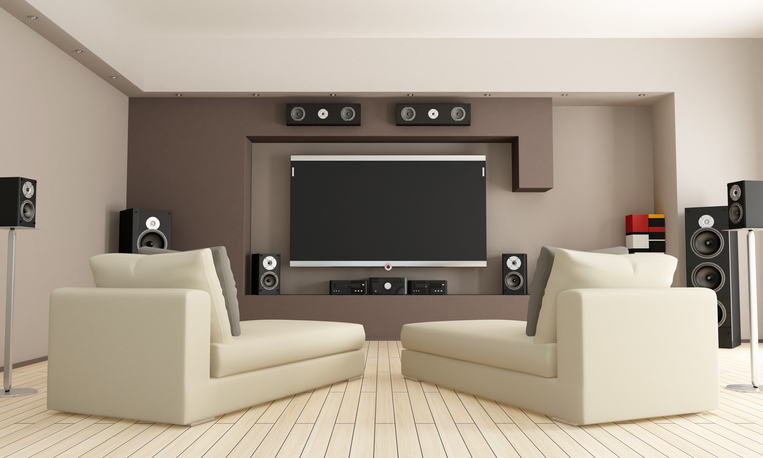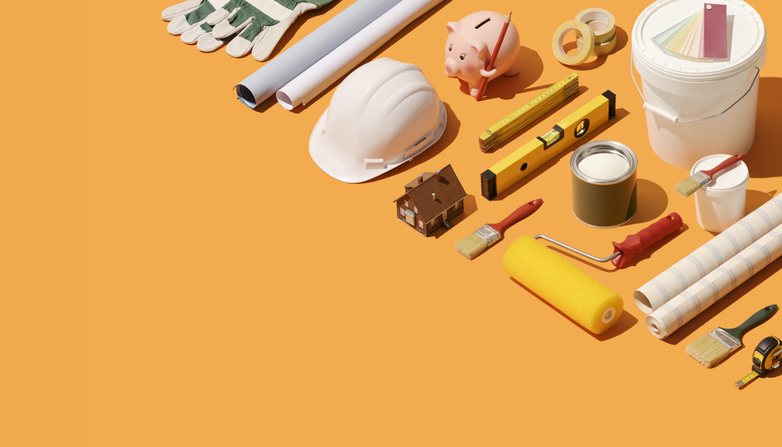Learning to paint a room correctly is essential for novice DIYers, new homeowners, and seasoned home improvement professionals alike. After all, it’s relatively painless, inexpensive, and simple to repair if something goes wrong. But, before you grab your roller and begin with your first coat, you must first devise a strategy. As a result, we asked a few experts for their best painting tips and tricks to get you started. Continue reading to learn how to paint a room and see what you’ll need to do step by step to ensure your project is a success.
DIY Painting VS Hiring a Professional Painter?
Can DIY Painting Save You Money?
So, you have decided to repaint that room, or even do some major renovations.
A great way to save money is to do the painting yourself.
Or is it?
You’ll need to research which paint to use, and buy all the right brushes, ladder, drop sheets, and cleaning materials.
You’ll be constantly under the critical eye of your spouse or partner.
Then, how much is your time worth?
In the end, that home magazine picture that inspired you, and your lounge room don’t have the same feel. That’s because the room in the picture was painted by professionals with an eye for detail and the right tools.
That’s what makes the difference between a DIY finish and a breathtaking color scheme.
When you engage a professional painter, the results they produce will nearly always be better than you can do yourself.
In the end, your home will look better, and the job will be guaranteed.
When you want great results, it is always best to trust the professionals.
Here are three top reasons why you should resist doing your own painting and call a professional team.
- Time
- Preparation
- Experience
Glenn Broadbent from Painters Newcastle
How to Paint Bathrooms with the Best Bathroom Paint?
When choosing the best paint for any room it’s important to consider functionality. Is it a high-traffic area? Are there often pets or young children in the space? How frequently do you want to have to repaint? When it comes to bathrooms (and to a lesser extent kitchens) you can add condensation to the list of considerations. In order to minimize the risk of mold, mildew, and paint deterioration (caused by lingering dampness) it’s a good idea to use paint that is wipeable and somewhat moisture resistant. For that reason, oil-based paints were often recommended for bathrooms. However, nowadays low-VOC, easy-clean, latex paints are a perfectly good (if not preferable) alternative. Acrylic and chalk paints would not be a good choice. There are latex paints on the market (in all finishes) that claim mold & mildew resistance and by all means, consider those. In my opinion, though, as long as you use a mold & mildew-resistant primer (which I recommend) regular latex paint will suffice. As far as finish goes, the rule of thumb is that the higher the sheen, the more durable, stain-resistant, and washable the paint. I recommend at least a satin finish for bathrooms. Depending on your preferred aesthetic you might even consider semi-gloss or gloss. If, like me, you are a stickler for flat ceiling paint then be prepared to repaint the ceiling more frequently. In my (very small) master bathroom, regular satin-finish latex paint has withstood heavy use for 18 years! I have repainted the ceiling twice in that period. As always be sure all surfaces are thoroughly clean and dry before you start, and avoid using the room while painting. And, to best preserve your newly painted room, keep moisture to a minimum by making sure you have adequate ventilation.
Sylvia Worsnop from Transforming Trash
Does Spraying Vs Brush Painting A House Have Better Results?
I prefer to use the brush or the spatula for the realization of decorative paints, Venetian stuccoes, and lime plasters, as in the case of Valpaint decorative paints. The brush also allows you to take care of the details better and to be much more precise, although compared to spraying it is much slower.
Gino Spadoni from Valpaint
How To Fix Peeling Paint On A Ceiling In 7 Steps
1. Find Out What’s Causing The Peeling
If it’s water damage you’ll want to fix the cause before fixing the peeling or it’ll just happen again. It could also just be old paint or worn from being in an area with high heat and humidity.
2. Identify The Type Of Paint On Your Ceiling
This is so you know what kind of paint to use to fix the peeling part. Using the same color and paint type helps keep your ceiling looking uniform.
3. Prepare The Area
This means moving things beneath the peeling area and putting down drop cloths. Moving things gets them out of the way and keeps them safe from paint. Putting down drop cloths helps catch any dust, paint chips, and stray paint, and makes cleanup easier.
4. Get Rid Of The Peeling Paint
Scrape off peeling paint on the ceiling using a putty knife. Lightly sand the area using 150-grit or higher sandpaper. Clean off any dust.
Sanding helps the patching compound, the primer, and the paint bond more tightly to your ceiling. This helps lower the chances of it peeling again.
5. Patch The Area
Patch the peeling area with a thin layer of patching compound and a putty knife. Let it dry and apply a second coat. Lightly sand and clean the area.
When you scrape and sand an area it ends up shallower than the ceiling around it. Patching levels the surface for a better-looking paint job.
6. Prime The Area
Prime the area with an oil-based primer and let it dry.
Priming helps the paint stick better to the ceiling so it lasts longer. It’s a good idea to have any fans on and windows open as the primer will have a strong smell.
7. Paint The Area
Paint the area with whatever type of paint is on your ceiling. Start in the middle of the area and spread out the paint, going lighter and lighter the further away you go from the middle.
Jimmy Cordier from Pinon Painting
When Is The Best Time To Paint My Home´s Exterior
Finding the perfect time to repaint the exterior of your house can be a difficult task. The biggest thing you have to take into account is the weather! Weather is huge when it comes to the outside painting because if it is too cold, too hot, or too wet it can be hard to get the paint to dry properly. The overall outcome of how the paint dries is directly related to the conditions at the time of application and throughout the drying process. Figuring out the perfect temperature can be an art form. You never want to paint when the ambient temperature is 50 degrees or lower, or else the paint will not hold up, even the most premium of paints. That makes winter and fall out of the question for your revamping job if the temperatures are low in your area. You’ll also want to avoid rainy or humid days because the moisture can cause an uneven application. Experts say that summer is the most appropriate time to paint the exterior of your house because of the warm, consistent temperatures and the probability of it being dry! But, you’ll want to also keep in mind that painting on extremely hot days should be avoided because temperatures over 85 degrees Fahrenheit can cause the paint to dry too quickly resulting in brush marks or clumps.
Tomas Martinez from Mike’s Quality Painting
How to Prepare For Painting Walls So You Have Less Mess
Painting walls can be both a daunting and messy task. For an interior wall refresh or color change, you want to be sure that you have all the necessary materials ready to go. This should include brushes, paint, painters’ tape, and painters’ plastic or drop cloths. Your first errand will most likely be to pick out your paint. This is an important step and when not considered carefully, can lead to one being unhappy with the finished product. Considering undertones and lighting of certain colors is very important. For example, one gray may look bluer than another due to the undertone of the paint or lighting of the room. The sheen, or gloss, of the paint, is another aspect that is often overlooked. There are different types of sheens including flat, satin, and semi-gloss. Flat is essentially a matte finish and can be easily scuffed and difficult to wipe clean. Satin is much more durable and washable and semi-gloss is mostly used for bathrooms or kitchens. We would recommend asking the paint store employee for assistance.
Now that you have your materials, let’s get started! First, be sure that all furniture is either removed from the room or moved to the middle of the room and covered carefully with painters’ plastic to protect it from paint splatter. You want to have plenty of space to move around! Procoat has been painting San Diego for over 25 years and we never skip the second step of the process which is making sure the walls are clean and the surface is smooth and ready for a paint coat. We do this by filling any holes and sanding them down. Thirdly, remove all outlet and light switch covers. A pro-tip is to keep your screws and plate covers in a container or plastic bag to keep all the pieces together! It is much more efficient than taping them off. Following the removal of the covers, you will take your painter’s tape and tape off any surfaces you are not painting, such as baseboards and trims of windows or doors. You want to be sure to keep the tape as close to the edging as possible because wherever the tape isn’t, the paint will be! We would highly suggest that drop clothes or painters’ plastic be used to protect your floors because accidents do happen. Another Pro Tip: If you are using painters’ plastic to protect your floors, be sure to put it down prior to taping off your baseboards as it will offer more protection and keep the plastic from moving.
Michael Mayhue from Procoat Painting San Diego
Paint Finish Types, Their Differences, And The Best Rooms For Them
There are roughly five main paint finishes, each with its distinct features and works best with specific sections in the home. If you’re planning to repaint your home and are confused about which paint finish to use, we hope this will help clear the air.
First, you have a high-gloss finish. An extremely durable paint finish, high-gloss paints are great for rooms that need better lighting due to their light-reflecting and shiny properties. Also, they’re easy to clean, making them perfect for your kitchen.
Next on our list is the semi-gloss finish. While not as durable or glossy as the high-gloss finish, this works best in rooms regularly exposed to moisture and grease. If you’re not into reflective and shiny walls, you can use this in your kitchen instead of the high-gloss counterpart. However, semi-gloss paints and bathrooms fit like a glove and a hand.
Now that you have ideas for the kitchen and the bathroom let’s think about what paint finish complements your dining room. While having a flat finish and little to no luster, the eggshell finish gives a clean and lovely touch to any room it’s used on. We recommend this finish for your kitchen, as it can further illuminate the room even with a few lights on. Plus, it’s easy to clean!
For high-traffic rooms like living rooms, you’ll need a paint finish that is easy to clean and highly durable. And for that, paints with a satin finish are your best bet. Combining the smooth, velvety qualities of the eggshell finish and the reflectiveness of its glossy counterparts, the satin paint finish will bring the best to your living room. And did we mention it cleans like a dream?
Last on our list, but certainly not the least, is the matte paint finish. While other paint finishes reflect light, this finish absorbs it like a sponge, making them perfect for bedrooms and office spaces. Additionally, matte finishes are great for covering up imperfections on the walls.
Gemala Afifi from Ijara CDC
The Best Paint And Stain And Primer For Your Exterior Wood Home.
What are the best painting supplies to have at home?
Painting can be challenging when you are not fully prepared. To fully avoid the challenge altogether it is smart to have the right painting tools. There are a lot of different painting supplies available to buy but the average homeowner doesn’t need them all. More necessarily doesn’t mean better. In this case, all you need are the right supplies to complete a painting project.
Some of the best painting supplies to have at home are as follows:
HIGH-QUALITY PAINT BRUSH
ROLLER AND CAGE
TRAY AND LINER
DROP CLOTH
BLUE TAPE
CAULK AND CAULK GUN
QUICK DRY SPACKLE
SPACKLE KNIFE
SANDPAPER
LADDER
RAGS
CUT BUCKET
MULTI-TOOL
- Always opt for a high-quality paint brush and roller. I assure you this will improve the final paint result. A paint tray and liner are a must. The liner aids in easy paint clean-up.
- A drop cloth is crucial. It protects your floors, furniture, etc from paint splatter. Sure, you can use old sheets or something of that nature but they are not 100% reliable. It’s best to have paint drop clothes on hand.
- Blue tape is useful for a couple of reasons. First, it is used to get clean crisp cut lines. Second, it can be used to take off fixtures that cannot be removed.
- A caulk gun is a tool that allows you to properly apply caulk or any type of sealant. Caulk is a product that is used to seal and fill in gaps and cracks. For instance, between a window frame and jamb or baseboards and the wall.
- Quick Dry Spackle is great to fill in any nail holes or imperfections that may be on your walls prior to painting. And the key to this spackle is that it dries quickly so no waiting around. To go along with spackle, a spackle knife is needed. It will seamlessly apply the spackle with ease.
- Continuing on, sandpaper is used to smooth out the spackle-filled holes or any other areas that need to be sanded down.
- A ladder is certainly another essential to have on hand. It will allow you to easily get to the ceiling to cut in.
- Rags are a must. Always have them on hand and within arms reach when painting. You want to be prepared to clean up any spills, drips, or so on.
- A cut bucket is specifically made to be able to comfortably fit on your hand while cutting in at the ceiling or paint trim. This will limit the number of accidents happening. Trust me I have been there.
- Last but far from least, a multi-tool. This is an excellent tool because as the name implies it is multi-use. For example, it can be used to open paint cans, as a scraper, or as a hammer. This is the one tool every professional painter always has on their person.
One great thing to remember is that some of these items are also multi-use. So you get more bang for your buck. The key takeaway here is that the right painting supplies will give you everything you need to paint a room with ease.
Cate Griffing from West Magnolia Charm
Can Wood Blinds Be DIY Painted At Home?
We don’t recommend attempting to DIY paint wood blinds at home since it would be a complicated process. Any simple DIY process such as using spray paints won’t work well on wood and won’t look all that great. The typical process to paint the wood slats (especially if they already have paint or stains on them) would be to sand the existing paint/finish off. Use coarse sandpaper first and then fine sandpaper to make the surface smooth. Once done the slats would need to be primed. Primer helps achieve a uniform paint/finish when painting wood. Once priming is done, use latex or oil-based paints with smooth and clean brush strokes. Make sure to use as few strokes as possible since brush strokes can be visible once dry if done incorrectly. Finally, add a few layers of top coat to protect the paint and give it a shine. Please understand the steps listed above are oversimplified and we don’t recommend attempting this if you are not familiar with working with wood.
Neal Panam from Zebra Blinds
What do you need for painting a graffiti at home?
Before getting started with painting a graffiti at home, there are several things to pay attention to in advance.
The first step is to get a concrete idea of the motif and size. If the idea is clear, it is important to make thoughts about the painting tools, as graffiti pieces can be realized with markers, spray cans, squeeze bottles, brushes, and other tools. The next step is to bring those parts together by making a concept wall. In many cases, it can be helpful to draw the concept wall on paper first in order to get familiar with the overall picture and its symmetry. Sometimes it is might be helpful to make stencils out of cardboard or to paint the motif with a pen in a light color first.
Once the concept wall is finished on paper or mind, it is necessary to check the surface that should be painted. Non-absorbent, smooth surfaces are often (not always!) easier to paint as absorbent surfaces that may soak in the pigments – depending on the painting tools that are used. The pre-treatment of the surface is maybe the most important step in this creating process. The surface should be clean, not greasy or dirty. If bright colors are desired, it is also helpful to prime the surface with a special primer (for a certain surface) or white emulsion paint. Before priming and painting, the floor should be covered with a canvas or some protecting sheets. After priming the wall, it is recommended to wait 24 hours in order to make sure the paint has dried completely.
The last phase of this creative process is about bringing the graffiti on the wall. When using spray cans for the graffiti it is absolutely necessary to buy an appropriate respiratory mask for professional use to avoid harm to health. Moreover, windows should be opened during the complete spraying process – also when wearing a mask! In addition, there are spray paints available with a high amount of water that replace volatile solvents e.g., the ONE4ALL spray with an amount of water of 85%. However, it is not possible to replace all solvents in a spray can, and as a result, a respiratory mask is inevitable.
To paint a graffiti, there are three basic steps:
1. Firstlines with a skinny cap in a light color (e.g., light yellow)
2. Fill-ins (a fat cap can be helpful)
3. Shadings, highlights, and effects.
As graffiti pieces require spatial imagination skills, regular training improves the outcome.
Laura Wolf from Molotow
What’s the difference between oil and latex paint?
The coating is formulated from four classes of ingredients: Pigments,binders, vehicles, and additives. When we speak of paints, varnishes orother coatings, we refer to them using generic terms that identify theirresin or binder types. Most architectural paint sold is consumer-friendly latex or oil-base paints. These are formulated and optimized for a variety of surfaces and exposures. Interior and exterior surfacesof masonry walls, wood trim, and metal structures have different needsfor protection and aesthetics. Every painting has a checklist of benefitsand limitations that painters must understand to maximize their returnon investment in a coating project.At this point in paint technology, the terms “oil” and “latex” arelegacy names from times long ago, but they serve to quickly choose theright coating for a particular job. There are no consumer-grade paints Iknow of that still use the collected sap of rubber trees, or latex, as abinder for coatings. Latex paints today are actually emulsions ofsynthetic materials such as vinyl or acrylic resins suspended in anaqueous solution. Likewise, although vegetable oils are used as thestarting ingredient of oil-based paints, they are modified chemicallyduring the resin-making process. Oil based paints are labeled “alkyd”due to the addition of alcohol and acids introduced into the mix to givethe resin better working properties and durability. Manufacturers arealso developing new beginning to find new ways of blending oil resininto waterbase creating “hybrid” coating technologies to get thebeneficial properties of both types.The additives part of the recipe helps to modify and optimize acoating for its expected use. Whereas 20 years ago, we would think twiceabout using latex paints on steel, there are now excellent waterbasemetal primers and direct-to-metal paints that perform very well andresist rusting and corrosion. Water-based paints have also been developedfor every use, including automotive paints.Benefits of latex paints:Low odorFast dryingSoap and water clean upZero and low VOC formulations to meet clean air regulations and user comfortLots of different products optimized for different surfaces and environmentsAvailable in all sheens and thousands of colors.Exterior acrylic formulations are long-lasting and non-chalking.Allows vapor to pass through, permeable filmNon-yellowingBenefits of oil-base paints:Strong, hard enamel finishFlow and leveling for a smoother finish compared to latex paintsAvailable in most sheens and thousands of colors.Resistant to household chemicalsBetter stain-blockingMoisture resistant filmThe dried film doesn’t stick to other painted surfacesBetter surface wetting for deeper penetration and better adhesionLimitations of latex paints:Softer film than oil-base paintsGenerally doesn’t sand wellAffected by cleaning chemicals and alcoholLimitations of oil-base paints:Solvent cleanupStronger, lingering odorSlower, longer dry timesNatural oils may support organic growthDo not use it on galvanized metal surfacesWhite and light colors may amberBenefits of Hybrid coatings:Hard enamel filmGood flow and levelingSoap and water cleanupLow odorFast dry timesWhere to use latex paints:Use on walls and ceilings over properly prepared surfaces. Excellent formasonry and drywall.Homes and commercial property inside and out.Where to use oil-based primers, paints, and varnishes:Use oil primers for blocking water stains, and rust inhibition on ferrousmetals or as enamel undercoated on wood.Excellent for doors, trim, cabinetry, banisters, tables, and stairs.Use oil paints on ferrous metal structures and equipment.Generally best reserved for interior surfaces or in controlled environments.It should go without saying that interior paints should be used insideand exterior paints are to be used outdoors. The paint companies areconstantly making strides to make their paints easy to use with improveddurability and still fit into the regulations that control how paint ismade and sold. There are hundreds of paint products on the market madefor every surface imaginable. Consumer and industrial manufacturers arefocusing their research on water-based/water-borne formulations, andnew better products are being introduced all the time. To address eachof these products, surfaces and environments are outside the scope ofthis article. Consult with your local paint store and let them know whatyou’re painting and what you expect to achieve so they can help youselect the right paint for the job.
What’s The Easiest Way to Choose Paint Colors?
A fresh coat of paint revitalizes any space, but how do you decide on a color? As with any home project, the right tool helps make things easier, plus gives you better results, which is why Datacolor’s ColorReader EZ is your go-to paint color selection tool. It replaces guesswork with color confidence. The ColorReader EZ device + ColorReader app, lets you scan the flat surface of an item to instantly find its top 3 paint color matches from your favorite paint brands. From there, tap on your color match to find coordinating hues for trim or ceiling, as well as whole room/house color palettes in complementary, monochromatic, analogous, or triad options.
The device saves your scanned color matches so you can organize them any way you’d like (by room, palette, project) and easily share them with others (friends, family, contractors). Here are 2 ways to get started using ColorReader EZ: Existing Room Items: If there are existing room items you’re keeping such as flooring, cabinetry, furnishings, etc., start by scanning one or more of them to find their paint color match, along with their coordinating colors.
Selecting paint colors that coordinate with existing pieces/surfaces helps tie the look of a room together. Even if you’re working with neutral colors, ColorReader EZ eliminates the guesswork (and disappointment!) that can come with selecting hues with the wrong undertones for your space – a reason why even a color like white can look “off” in a room. Color Inspiration: Planning on a complete room redo? Let inspiration (and ColorReader EZ) be your color guide! Scan colors you love from existing objects, such as a favorite shirt, piece of pottery, leaf, or flower, to find its paint color match and coordinating hues. Find tips on using your ColorReader EZ here. Pro Tip: Know Your Room Orientation. The direction in which your room faces affects the “color temperature” of the light it receives. Rooms that face South or West receive warmer light (more yellow) than rooms that face North or East, which receive cooler (bluer) light. As you might expect, using warm colors in warm light or cool colors in cool light intensifies colors, while opting for temperature complements – cool colors in warm light, warm colors in cool light – helps balance things out.
Lydia Fedos from Datacolor
Learning how to paint a room correctly is essential for novice DIYers, new homeowners, and seasoned home improvement professionals alike. After all, it’s relatively painless, inexpensive, and simple to repair if something goes horribly wrong. But, before you grab your roller and begin with your first coat, you must first devise a strategy. As a result, we asked a few experts for their best painting tips and tricks to get you started. Continue reading to learn how to paint a room and see what you’ll need to do step by step to ensure your project is a success.




